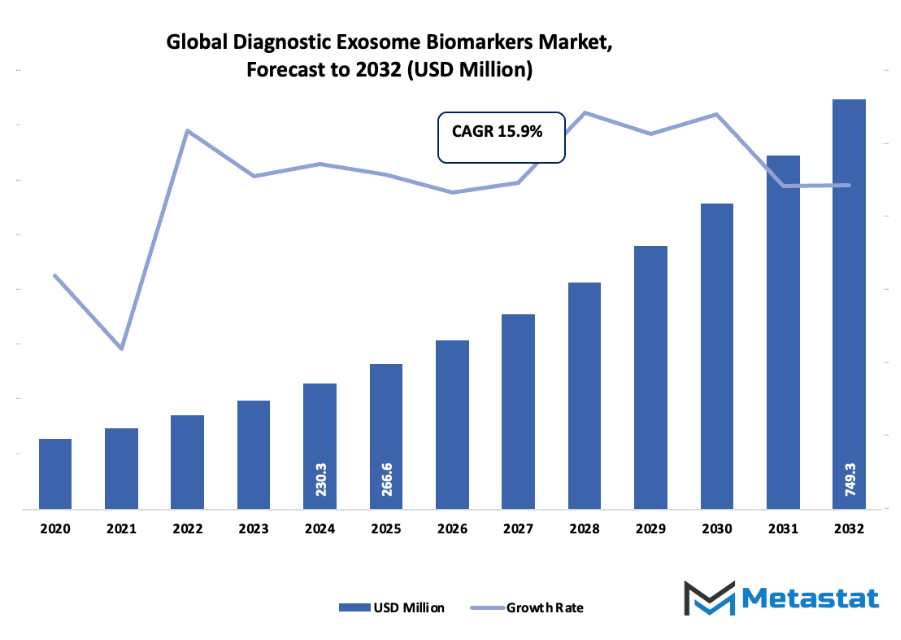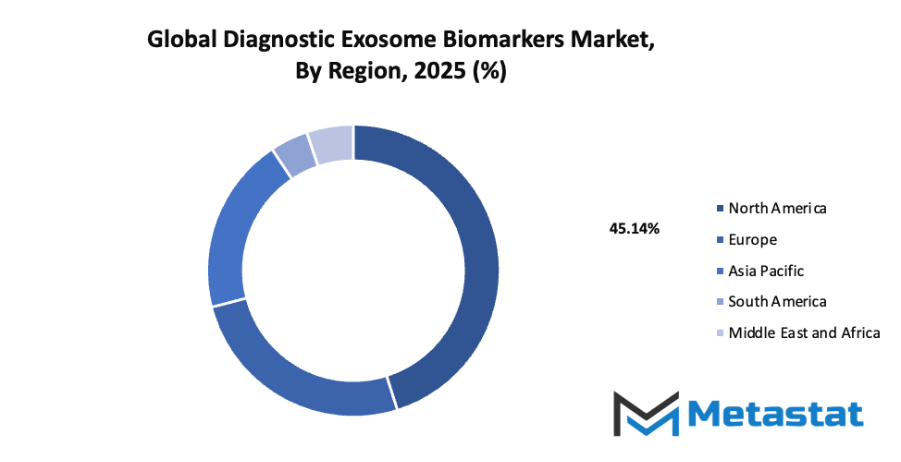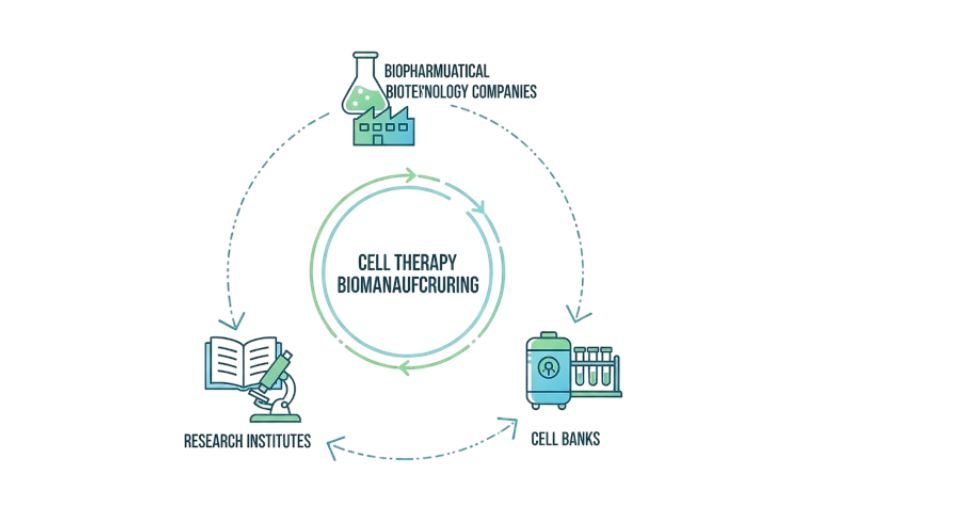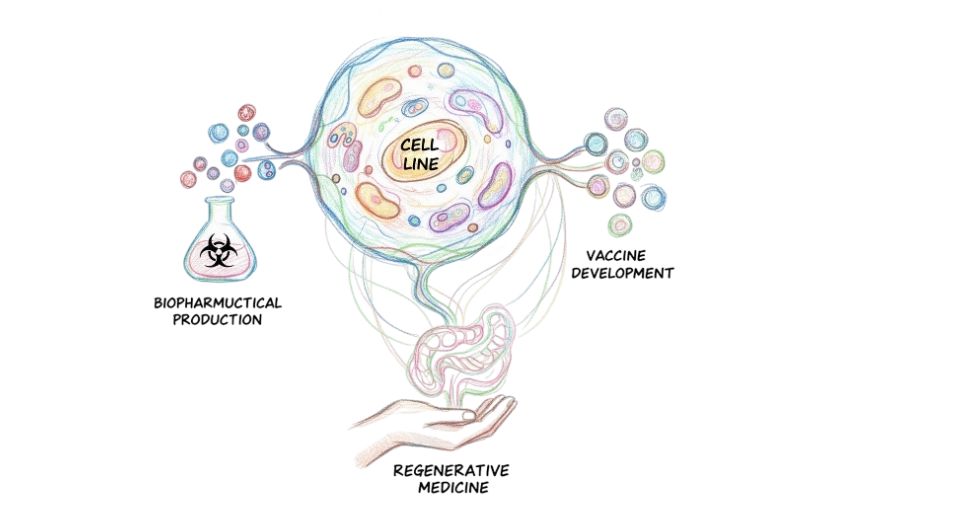Global Diagnostic Exosome Biomarkers Market - Comprehensive Data-Driven Market Analysis & Strategic Outlook
The healthcare and biotechnology sector across the globe will have its global diagnostic exosome biomarkers market as a pioneering division that will be fueled by the growing need for non-invasive diagnosis and personalized medicine. The origin of the division will date back to the early 2000s when exosomes were recognized as cell messengers that transmit proteins, lipids, and nucleic acids, and scientists were curious about what they can do in the detection of diseases. The earlier research phase focused on establishing the biological relevance of exosomes, and this led to opportunities for using laboratory findings in diagnostic tests. The 2010s witnessed improvements in the methods of isolation using ultracentrifugation and microfluidic platforms that provided precise and reproducible identification of biomarkers in exosomes, and this added clinical translatability.
- Global diagnostic exosome biomarkers market size of roughly USD 266.6 million in 2025 and is projected to develop at a CAGR of roughly 15.9% for the period 2032, with a potential reach value of over USD 749.3 million.
- Circulating Exosomes holds a market share of roughly 63.8%, sustaining innovation and increasing applications through aggressive research.
- Major growth drivers: Rising Demand for Non-invasive Diagnostic Products, Technology Innovation in Exosome Isolation and Analysis Systems
- Chances are: Increasing Emphasis on Personalized Medicine and Precision Diagnostics
- Essential insight: The market will witness exponential growth in value over the next decade with sound growth opportunities highlighted.
- In this period, research in cooperation with academic institutions and biotech companies gave rise to pilot studies demonstrating the promise of exosomes for cancer, neurodegenerative disease, and cardiovascular diagnostics.

Regulatory guidelines will also develop as the regulators come to realize the special difficulties in standardizing the diagnostics of exosomes, which will inform approval mechanisms and guarantee safety and effectiveness. Consumer forces will increasingly become dominant in defining the direction of this marketplace, where physicians and patients will look for minimally invasive diagnostic equipment that is highly accurate and can yield early diagnosis, especially for diseases with limited conventional testing capability. Technological innovation will be one of the drivers, as development in high-throughput sequencing, proteomics, and artificial intelligence-assisted interpretation of data will increase the power and speed of exosome analysis. The market will further see the growth of point-of-care solutions and liquid biopsy applications to bring exosome biomarker testing to a range of healthcare centers.
Strategic collaborations and acquisitions are likely to optimize the transfer of research advancements into successful commercial products as regulatory systems evolve to drive innovation while not exposing patients to risk. In the coming years, the diagnostic exosome biomarkers market globally will also continue to revolutionize diagnostic paradigms by linking molecular biology knowledge with useful clinical utility. Its evolution from mysterious cellular constituents to characterized diagnostic reagents will pave the way for a future with improved detection of disease at an earlier point in time, customized, and more accessible, and in the end, affecting treatment strategy and healthcare outcomes across the globe.
Market Segments
The global diagnostic exosome biomarkers market is mainly classified based on Type of Exosomes, Application, Technology, End User.
By Type of Exosomes is further segmented into:
- Circulating Exosomes: Circulating exosomes shall be among the major drivers of the global diagnostic exosome biomarkers market as they can be conveniently obtained from blood. They contain useful biological information that shall enable non-invasive monitoring. Sensitivity enhancements in detection technologies shall make circulating exosomes propel precise disease monitoring and early diagnosis in a broad range of therapeutic indications.
- Cell-Derived Exosomes: Cell-derived exosomes will provide crucial data in the global diagnostic exosome biomarkers market as they indicate cell status and disease advancement. They will enhance diagnosis, notably in the detection of particular cell sources of disease. Through increased research, these exosomes will facilitate appropriate medical decisions and personalized care strategies.
- Microvesicles: Microvesicles will continue to hold a central position in the Diagnostic Exosome Biomarkers market globally as they transport molecular information associated with disease conditions. They will enable high-end diagnostic equipment for the identification of shifts in cell behavior. Innovation will only refine microvesicle-based testing to the point that it will be dependable for early diagnosis and decision-making.
- Apoptotic Bodies: Apoptotic bodies will gain more importance in the Diagnostic Exosome Biomarkers market globally since they are indicators of signaling programmed cell death. They will be researched further to learn more about different diseases, particularly cancer. Detection of apoptotic bodies will become more efficient with technological improvement, supporting better diagnostic procedures and enhancing patient monitoring systems.
By Application the market is divided into:
- Cancer Diagnosis: Cancer diagnosis will be the focus of the global diagnostic exosome biomarkers market since exosomes provide precise markers of the presence of a tumor. Non-invasive procedures will become more effective to identify cancer in an earlier stage. Greater utilization of these biomarkers in the years ahead will make screening programmes better and will make targeted therapy protocols available for patients globally.
- Neurological Diseases (such as Alzheimer's Disease): Neurological diseases will create increasing opportunities for the international Diagnostic Exosome Biomarkers market. The study of exosomes will enable the detection of the first signs of diseases such as Alzheimer's, even before symptoms arise. Ongoing developments will provide diagnostic aids that will allow for timely treatment, with potential for better control of neurological diseases in populations.
- Cardiovascular Diseases: Cardiovascular diseases will also fuel growth in the global diagnostic exosome biomarkers market. Exosome biomarkers will allow for the detection of cardiac-related risks using non-invasive tests. Emerging innovations will enhance predictive capacity so the healthcare system can intervene early and lower heart failure, stroke, and associated disease complications.
- Infectious Diseases: Infectious diseases will determine the demand for the global diagnostic exosome biomarkers market as precise identification tools will prove to be essential. Exosome-based diagnostics will quickly detect the pathogens, promoting the application of early interventions. The greater the infectious threats, the higher the relevance of such biomarkers in enhancing public health surveillance and clinical response systems.
- Others: Other uses in the worldwide Diagnostic Exosome Biomarkers market will be autoimmune and metabolic disorders. These indications will gain advantage through exosome quantification to monitor disease state and drug effect. Additional research expanding into these categories will position biomarkers within more holistic healthcare strategies, opening the way for future diagnosis innovation beyond their current applications.
By Technology the market is further divided into:
- Isolation and Purification Technologies: Isolation and purification technologies will continue to be at the forefront of the Diagnostic Exosome Biomarkers market globally. Better technologies will yield high-quality samples of exosomes for correct testing. Novel processes will accelerate and be less expensive, facilitating mass clinical utilization and diagnostic dependability to become achievable across a wide range of healthcare applications globally.
- Characterization Technologies: The characterization technologies will be greatly upgraded in the world Diagnostic Exosome Biomarkers market to allow more analysis of exosome features. The technologies will identify molecular signatures required for diagnosis. The characterization technologies will be optimized in the future to provide reproducible results to ascertain accuracy in clinical and research applications.
- Analysis Technologies: Analysis technologies will be crucial to the global diagnostic exosome biomarkers market because they transform raw data into useful information. Improvements will render results more consistent, facilitating individualized treatment plans. These technologies will improve still further, enabling healthcare professionals to detect faint disease markers more precisely and with more confidence.
By End User the global diagnostic exosome biomarkers market is divided as:
- Hospitals & Clinics: Hospitals and clinics will be leading end users in the global diagnostic exosome biomarkers market. Integration of exosome-based diagnostics will allow quick decision-making in patient care. With increased adoption, hospitals will rely on these technologies to enhance treatment planning, improve survival rates, and support better patient experiences.
- Diagnostic Laboratories: Diagnostic laboratories will play a vital role in expanding the global diagnostic exosome biomarkers market. These facilities will handle advanced testing and deliver precise results. As demand grows, laboratories will continue adopting new technologies to ensure faster turnaround, high accuracy, and scalability for both routine and complex diagnostic needs.
- Research Institutes & Academic Centers: Research institutes and academic centers will drive innovation within the global diagnostic exosome biomarkers market. They will focus on exploring new biomarker applications and developing advanced detection methods. Future contributions from these institutions will ensure continuous progress, shaping diagnostic tools that directly benefit healthcare systems and patients.
|
Forecast Period |
2025-2032 |
|
Market Size in 2025 |
$266.6 Million |
|
Market Size by 2032 |
$749.3 Million |
|
Growth Rate from 2025 to 2032 |
15.9% |
|
Base Year |
2024 |
|
Regions Covered |
North America, Europe, Asia-Pacific, South America, Middle East & Africa |
By Region:
- Based on geography, the global diagnostic exosome biomarkers market is divided into North America, Europe, Asia-Pacific, South America, and the Middle East & Africa.
- North America is further divided into the U.S., Canada, and Mexico, whereas Europe consists of the UK, Germany, France, Italy, and the Rest of Europe.
- Asia-Pacific is segmented into India, China, Japan, South Korea, and the Rest of Asia-Pacific.
- The South America region includes Brazil, Argentina, and the Rest of South America, while the Middle East & Africa is categorized into GCC Countries, Egypt, South Africa, and the Rest of the Middle East & Africa.

Growth Drivers
- Increasing Demand for Non-invasive Diagnostic Tools: The global diagnostic exosome biomarkers market will benefit from the increasing shift toward non-invasive testing methods. Patients and healthcare providers prefer procedures that reduce risk, discomfort, and recovery time. This demand will lead to greater use of exosome-based biomarkers, which provide accurate results without relying on invasive techniques.
- Advancements in Exosome Isolation and Analysis Technologies: The global diagnostic exosome biomarkers market will see strong growth as technologies for isolating and analyzing exosomes continue to improve. More efficient, faster, and accurate methods will enhance research and clinical application. These advancements will open new possibilities in disease diagnosis, monitoring, and potential therapeutic development.
Challenges and Opportunities
- Lack of Standardization in Biomarker Detection Methods:
The global diagnostic exosome biomarkers market will be limited by a lack of clear and consistent methods for biomarker detection. Without standard protocols, research findings and clinical applications may vary, slowing wider adoption. Overcoming this issue will require international collaboration and unified guidelines to build reliability and trust. - Regulatory Hurdles and Compliance Challenges:
The global diagnostic exosome biomarkers market will encounter challenges in meeting strict regulations and compliance demands. Approval processes can be lengthy and costly, delaying innovation from reaching patients. Addressing these barriers will be necessary to ensure timely adoption while maintaining safety, accuracy, and quality of diagnostic solutions.
Opportunities
Growing Focus on Personalized Medicine and Precision Diagnostics:
The global diagnostic exosome biomarkers market will benefit greatly from the rising focus on personalized medicine and precision diagnostics. Exosome biomarkers offer valuable insights tailored to individual patient profiles, supporting accurate diagnosis and targeted treatments. This trend will drive demand, ensuring long-term growth and integration into healthcare systems.
Competitive Landscape & Strategic Insights
The global diagnostic exosome biomarkers market is steadily gaining recognition as a crucial segment of healthcare innovation, where rapid scientific progress continues to open new opportunities. The industry is a mix of both international industry leaders and emerging regional competitors, each contributing to the growing landscape with advanced technologies and unique approaches. Important competitors include Bio-Techne, Codiak BioSciences, Evox Therapeutics, Ceres Nanosciences, PureTech Health, System Biosciences, NanoView Biosciences, ExoDx, Exosome Sciences, Aethlon Medical, Inc., HansaBioMed Life Sciences Ltd., Hitachi Chemical Diagnostics, Inc., Illumina, Inc., NanoString Technologies, Inc., Norgen Biotek Corp., Oxford Immunotec Global PLC, Qiagen N.V., Sistemic Ltd., Sysmex Corporation, Thermo Fisher Scientific Inc., VolitionRx Limited, Bio-Techne Corporation, New England Biolabs, Inc., Takara Bio Inc., and Miltenyi Biotec. Each of these organizations plays a key role in shaping the future of the market by pushing forward advancements in diagnostics, precision medicine, and molecular research.
Looking ahead, this market is expected to witness significant transformation as demand for non-invasive diagnostic tools becomes stronger worldwide. Exosome biomarkers hold potential to change how early disease detection is approached, particularly in areas such as cancer, neurodegenerative conditions, and infectious diseases. Unlike conventional diagnostic methods, this technology allows for highly accurate analysis while minimizing discomfort to patients. Over the coming years, the increasing acceptance of exosome-based diagnostics could lead to faster clinical decisions, reduced healthcare costs, and improved patient outcomes on a global scale.
As research intensifies, global competition will likely become even more dynamic. Established corporations bring with them robust infrastructure, strong distribution networks, and financial resources to advance large-scale projects. Meanwhile, smaller regional competitors often introduce fresh ideas, agile innovation, and niche expertise, enabling them to respond quickly to specific medical challenges. The interaction between these forces creates a diverse and competitive environment, which in turn drives innovation and accelerates the commercialization of novel diagnostic platforms.
In the future, partnerships between technology providers, research institutions, and healthcare facilities will become increasingly important. Collaborations will allow for faster translation of laboratory findings into clinical applications, ensuring that discoveries can reach patients without unnecessary delays. At the same time, regulatory frameworks will continue to adapt to keep pace with rapid scientific developments, striking a balance between safety, efficacy, and timely market access.
Market size is forecast to rise from USD 266.6 million in 2025 to over USD 749.3 million by 2032. Diagnostic Exosome Biomarkers will maintain dominance but face growing competition from emerging formats.
With advances in artificial intelligence, bioinformatics, and molecular analysis, the Diagnostic Exosome Biomarkers market is positioned to redefine standards in medical testing. The combination of cutting-edge research, competitive business strategies, and strong clinical demand will guide this industry into a phase where precision diagnostics are more widely available and more affordable. In this future, the efforts of both long-established corporations and innovative newcomers will ensure that the market remains one of the most promising frontiers in modern healthcare.
Report Coverage
This research report categorizes the global diagnostic exosome biomarkers market based on various segments and regions, forecasts revenue growth, and analyzes trends in each submarket. The report analyses the key growth drivers, opportunities, and challenges influencing the global diagnostic exosome biomarkers market. Recent market developments and competitive strategies such as expansion, type launch, development, partnership, merger, and acquisition have been included to draw the competitive landscape in the market. The report strategically identifies and profiles the key market players and analyses their core competencies in each sub-segment of the global diagnostic exosome biomarkers market.
Diagnostic Exosome Biomarkers Market Key Segments:
By Type of Exosomes
- Circulating Exosomes
- Cell-Derived Exosomes
- Microvesicles
- Apoptotic Bodies
By Application
- Cancer Diagnosis
- Neurological Disorders (e.g., Alzheimer’s Disease)
- Cardiovascular Diseases
- Infectious Diseases
- Others
By Technology
- Isolation and Purification Technologies
- Characterization Technologies
- Analysis Technologies
By End User
- Hospitals & Clinics
- Diagnostic Laboratories
- Research Institutes & Academic Centers
Key Global Diagnostic Exosome Biomarkers Industry Players
- Bio-Techne
- Codiak BioSciences
- Evox Therapeutics
- Ceres Nanosciences
- PureTech Health
- System Biosciences
- NanoView Biosciences
- ExoDx
- Exosome Sciences
- Aethlon Medical, Inc.
- HansaBioMed Life Sciences Ltd.
- Hitachi Chemical Diagnostics, Inc.
- Illumina, Inc.
- NanoString Technologies, Inc.
- Norgen Biotek Corp.
- Oxford Immunotec Global PLC
- Qiagen N.V.
- Sistemic Ltd.
- Sysmex Corporation
- Thermo Fisher Scientific Inc.
- VolitionRx Limited
- Bio-Techne Corporation
- New England Biolabs, Inc.
- Takara Bio Inc.
- Miltenyi Biotec
WHAT REPORT PROVIDES
- Full in-depth analysis of the parent Industry
- Important changes in market and its dynamics
- Segmentation details of the market
- Former, on-going, and projected market analysis in terms of volume and value
- Assessment of niche industry developments
- Market share analysis
- Key strategies of major players
- Emerging segments and regional growth potential








 US: +1 3023308252
US: +1 3023308252






